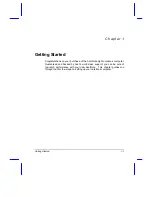
Introduction
External Locator - Bottom View 1 - 7
1.Introduction
External Locator - Bottom View
Figure 6
Bottom View
1. Vent
2. Component Bay
Cover
3. Sub Woofer
4. HDD Bay
5. Battery
Overheating
To prevent your com-
puter from overheating
make sure nothing
blocks the vent/fan in-
takes while the com-
puter is in use.
3
2
1
4
5
1
1
1
Summary of Contents for P150SM-A
Page 1: ......












































